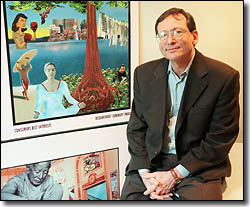Mighty metaphors — Zaltman’s method opens the ‘windows of consciousness’

When the Heinz Endowments of Pittsburgh, Pa., embarked on a mission two years ago to invigorate its Arts and Culture program, it turned to the Mind of the Market Laboratory (MML) at the Harvard Business School (HBS). What emerged from the lab was a multifaceted advertising campaign built around a series of energetic and colorful images, designed to boost the profile all of the arts in Pittsburgh.
Sponsors say the endeavor has been a tremendous success.
The Heinz campaign is emblematic of the state-of-the-art marketing research being conducted at the MML. Bridging together theories and tools from disciplines ranging from psychology to neuroscience, the lab attempts to define and qualify consumers and managers thoughts and feelings about an array of constructs, from “loyalty” to “privacy” to “chocolate.”
The work is spearheaded by the labs co-director, HBS Joseph C. Wilson Professor of Business Administration Gerald Zaltman, whose patented interview method, the Zaltman Metaphor Elicitation Technique (ZMET), is the foundation of the MMLs data-gathering process. Stephen Kosslyn, the labs other co-director, is a professor of psychology at Harvard.
ZMET is an interactive technique that requires survey subjects to do their homework. They are asked to choose at least eight photographs or other visual images taken from magazines, catalogs, or photo albums that represent their feelings on the topic. Zaltman says subjects are given several days to ponder the issue before the interview. “That way, they come in at a fairly high state of readiness, with a lot to say,” he explains.
Working with a professional interviewer and a specialist in digital imaging, the subject is led through a series of analytical conversations, based on the pictures, during a two-hour interview session that is designed to uncover deeper meanings and hidden thoughts about the topic. “This is all done in a very special way,” Zaltman says, “in which we probe their thoughts, as opposed to prompt for answers. Theres a very big distinction.
“What were doing is using metaphors, idiomatic expressions of consumers, as vehicles for them to transport what may exist below their level of awareness into a domain of awareness,” Zaltman says. “Basically, we help the consumer open windows into their own thinking. We encourage them to look in, and share with us what they see.”
Opening the windows of consciousness can be a complex and revealing process, and the results are often fascinating, according to Zaltman. “Often people will comment at the end of the interview that they didnt know they had so many thoughts about the topic, or theyre talking about how surprised they are, in terms of discovering just how strongly they felt about the subject matter.”
It is that outcome that the MML, utilizing ZMET, strives to capture. “I feel theres a lot of opportunity for doing some innovative work that would enable us to understand better what consumers are saying they want, even to understand better how managers are approaching that task,” Zaltman explains. “Its not clear that these things will pay off. We suspect there will be some dead ends, but as long as we learn something when reaching a dead end, its still a plus, and if we work hard enough, some of the things we do will be breakthroughs.”
A sampling of recent MML projects includes studies focusing on consumer loyalty and on the future of customer behavior. The lab is also working with private sector clients to produce reports on “Corporate and Product Name Associations,” for General Motors, “Thoughts and Feelings About Going to the Dentist,” for Futuredontics, and “The Meaning of Chocolate,” for Nestlé.
The MML has also begun exporting its work overseas to a dozen other countries, including China, Japan, and Great Britain. “One of the most interesting things about this research is that when we dig deeply, you start to find that what seemed to be very different people have lots in common, and it takes very few interviews to get at core variables that are constructs shared among very different people,” Zaltman says.
Concepts like respect, honesty, and dependability often score high in MML studies, while traits such as aggressiveness, dishonesty, and unreliability score low. “We have done the very same project in several countries, as diverse as Great Britain and Japan, and at a very deep level, the very same basic issues are what drives peoples thinking.”
Zaltmans next project is an ambitious one. Next month, hell participate in a World Bank youth summit in Macedonia. “A couple of hundred youth from a large number of countries [will be there],” he says, “and these youth will express their visions of the economic future through art, poetry, essays, sculpture, paintings, photographs, and what have you. [Ill] be involved in trying to understand the data.
“Its quite exciting, because youve got tomorrows leaders and consumers and entrepreneurs from all different countries, and this is a very special opportunity to try to understand their minds more fully,” Zaltman explains. “It also provides the opportunity to offer various structural tools or devices to further develop those minds or help satisfy their curiosities and needs, so its going to be fun.”
The World Bank Youth Summit in Macedonia is a long way from the Arts and Culture program in Pittsburgh, certainly, but for Zaltman and the MML, the mission remains the same to shine a light on the inner soul, to reveal the hidden thoughts and motivations in the subconscious, and to learn more about what makes people behave the way they do.




